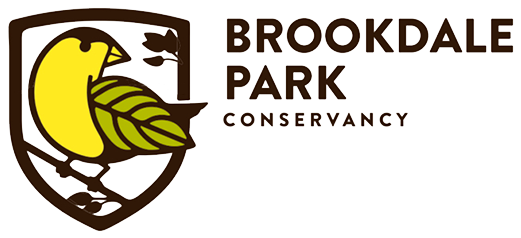by Jean Greeley
Life long nature lover, biologist and master gardener, Jean Greeley conceived and brought to life Brookdale Park's Monarch Waystation & Pollinator Garden. We are thrilled to share her brilliant stories on what is REALLY happening in our winter gardens - be amazed! Don't miss the links to winter project for kids and teens at the end!
Estimated read time: 2 minutes
If you were to take a walk through the Brookdale Park Pollinator Garden today you might not be too excited by what you see - just dried up plant stems, last year's leaves, dead branches from nearby trees - certainly nothing to write home about. Truth be told however, there IS MUCH to be excited about! That garden is as alive now as it was in the middle of summer - just more subtle and unseen.
Let's look at it through a different lens. Those dead stems that were once green and juicy and now dried up and more hollow inside? They make perfect winter homes for insect larvae. Look for seed heads where flowers once bloomed and you'll find hundreds of seeds - the fruits of pollination by bees, wasps, butterflies, and many other insect species. These seeds are winter food for our non-migrating birds and also for mammals in search of a winter meal, and they also stand ready to be carried away by wind, rain, and passing animals to new resting places, ready to sprout into new plants in seasons to come.
The dry leaves that were purposely left on the ground serve as a perfect over-wintering environment for insects at various stages of development - caterpillars (larvae), moth cocoons (pupae), eggs, and even adult insects. Stoop down and brush aside some leaves here and there and you just might discover a cocoon or a cold, somewhat stiff caterpillar (please remain on footpath and be careful to leave them be).
While searching you also might see small holes in the ground. These are entrances to ground-nesting insect cavities and serve as cozy earthen homes for eggs, larvae, and even some adult ground-nesting bees and wasps that once buzzed around the garden just a few months ago. You may also find larger holes, which are entryways to large, intricate underground burrows where chipmunks hunker down for the winter. Any evidence of living things you may come across is just a fraction of the vast soil ecosystem of plant roots, fungi, worms, slugs and snails, microorganisms, and more...all alive, growing, producing food, and reproducing underground at a slow winter's pace.
Above ground once again, look for green leaves at the base of some plants, such as tall white beardtongue or foam flowers. The basal leaves of these plants stay a muted green all winter, and in large numbers act as ground covers. You'll also notice the basal rosettes of common evening primrose dotting the landscape, adding a touch of purple-tinged green to the browns and grays.
When your stroll through the winter garden is over and it's time to walk away, you will hopefully see the garden as not too shabby, and carry with you a better appreciation and understanding of the Amazing Winter Garden.
Winter DIY Fun for Kids & Teens:
The world outside is a wonder to explore. Connect your family to nature with these fun DIY projects:
Easy Bug Hotel DIY for Children
Winter Gardening Activities for Children
Indoor Winter Garden Fun
Make Berlese Funnels to Study Biodiversity - Teen Project






